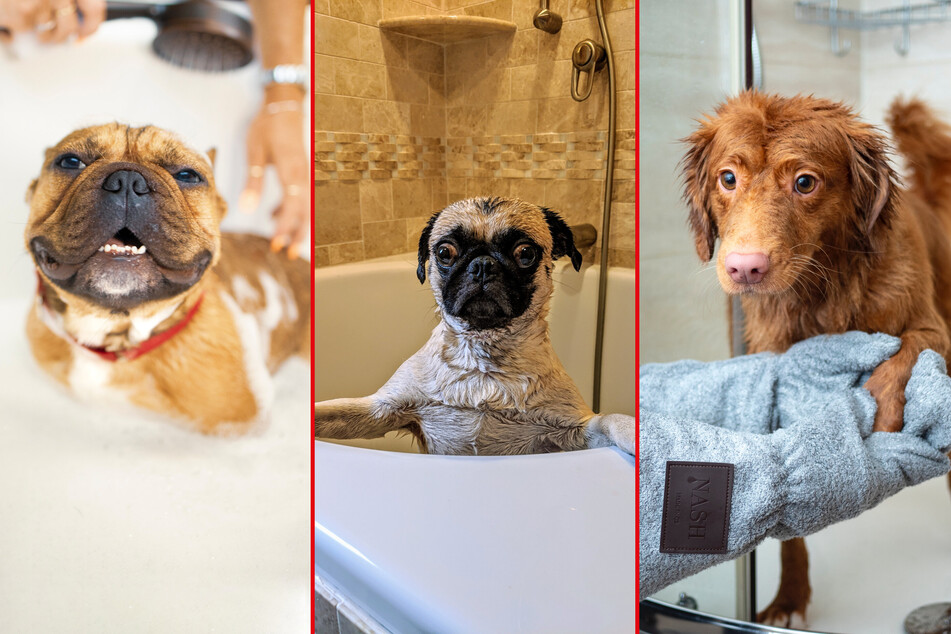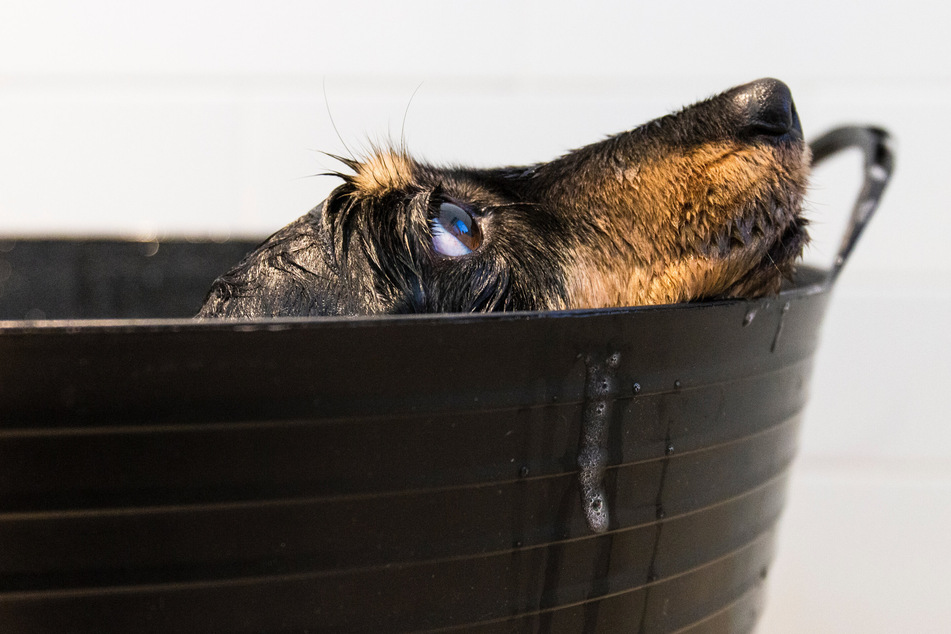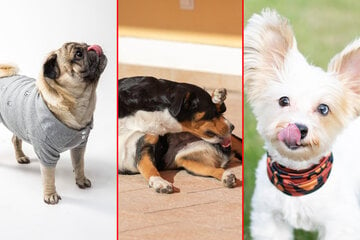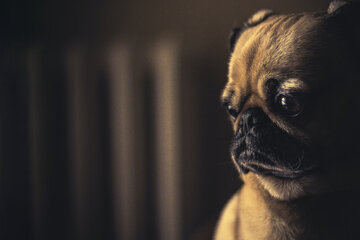How to bathe a dog and how often: Giving a dog a bath
Dirty dogs can leave a trail of muck and destruction all through your house. Seeing as they'll be filthy after most walks, it's a good idea to know how to bathe your dog properly, when it's necessary, and how often to do so.

Anyone who has ever owned a dog will have experienced that exasperated feeling in their chest as their perfect pooch lunges into the lake. They emerge dripping, muddy, and filthier than a fish. It's a pain to get them clean again and yet, if you don't, you're going to have one messy house.
In this dog guide, TAG24 will take you through how to give your dog a bath. How should you wash your dog, how often is ideal, and why is it so important? Let's find out.
How to wash your dog
Giving your dog a solid bath can be a difficult process, especially if your perfect pooch doesn't like water. It's important to prepare your dog for its wash, so that it knows what's coming up and isn't too scared. Prepare thoroughly beforehand, and then make the process a ritual that your dog can learn and be ready for.
Here's how to bathe your dog
Step 1: Prepare for the bath by choosing your method of bathing (take a look at the home options below), buying a commercially available dog shampoo (it must be a shampoo specifically made for dogs, and approved by your vet) and getting everything set up (get the water to the right temperature, fill the tub).
Step 2: Give your doggo plenty of pats and cuddles, make it feel happy and give it a little treat. Maybe play with it for a little while, do some puzzles or some agility training, and then calm it down with a cuddle.
Step 3: Start by giving your dog a long and thorough brush, making sure that its hair is free of any tangles and is unmatted, so that the shampoo can clean thoroughly, and things don't get difficult as its fur dries.
Step 4: After double-checking that the water isn't too hot, place your dog in the water and, while petting it and showing it love, make sure that its whole body gets wet (except for its face).
Step 5: Once your dog is all wet, and the water has got all up underneath its coat, it's time to apply the shampoo. Rub on a generous amount and get it right down to the bottom of each hair, so that it is fully covered in the stuff. Be careful, though, not to get it into the dog's eyes, nose, ears, or mouth. Keep the shampoo away from your dog's head.
Step 6: Rinse off all the shampoo, being especially careful to get it completely out of your dog's fur. Use the warm water and be rigorous to guarantee that all the shampoo foam has disappeared.
Step 7: Use a clean towel (not a hair drier) to dry your dog, starting off rigorously to make sure that all the serious water has been removed. After that, swap to another towel and go more carefully, brushing as you dry to make sure that its fur does not dry in tangles or mattes.
Step 8: Give your dog a treat and have a cuddle with it. Perhaps it's dinner time?
Keep calm and carry on: Your dog may struggle at first, but it will slowly get used to taking baths and will eventually grow to like it. The best thing to do is to turn this process into somewhat of a ritual - always do it the same way, take your dog through the same steps, and make everything very predictable. This is again an example of why dogs should be trained from an early age.
How to give your dog a bath at home
You don't need to go to a proper dog groomer to have your pooch perfectly cleaned and scrubbed. Feel free to do it yourself at home, following the instructions above, but making sure to do it in a sterile and safe environment. What examples are there of safe and sanitary environments at home, though? Let's take a look.
Here's how you should bathe your dog at home
In the bath: Fill up your bathtub so that it is halfway up the height of your dog. You need to make sure that the water is up to its undercarriage but doesn't go over its head, so that it can stand up easily in the water. Additionally, keep the water at a relatively warm but not-too-hot temperature. You need the heat to aid in the cleaning process, but not as hot as you would have it when taking a bath.
In a plastic tub: We're talking about a giant plastic tub, not a bathtub. Ultimately, this serves as a massive bowl, in which you are making dog and soap soup. Fill it up with water in the same way you would a bath, and give your doggo an outdoor, au naturel experience.
In a kiddie pool: Do you have a kiddie pool lying around? If so, blow it up and fill it as previously described. Just make sure that your dog's claws have been clipped and aren't too sharp. You don't want to make the balloon burst.
Shower your doggo: Pop your swimsuit on and jump in the shower with your doggo. Keep the water a tepid temperature, even if that is a little unpleasant for yourself, and keep the water pressure low. You don't want to burn or scare your dog.
Don't do this: A paddling pool is fine, but don't go bathing your dog in your swimming pool (if you have one). Of course, it's kind-of okay if your dog can swim, but you also need to think about the mess. Do you really want to empty your pool to get rid of all the soap and stuff? Sounds expensive!

How often should you bathe your dog?
It is generally recommended that you bathe your dog around once every month, but no more than once a week. If you wash your dog too often it can develop skin conditions due to the various chemicals you will use during the cleaning process. On top of that, prolonged exposure to water can have strange effects on your dog's coat, as well as its eyes and paws.
The first thing you need to do when deciding on how regularly you give your dog a bath (excluding the circumstances where your dog has got itself insanely dirty, of course) is to establish which coat type it has. There are many different types, and each have different cleaning and grooming requirements.
Once this has been established, you need to consider your dog's lifestyle and any health conditions it may have. Get advice from your veterinarian, as they will be able to give you an indication of how your dog's pre-existing issues will influence its cleaning cycle.
The issue is that over-washing can cause problems with your dog's hair quality, can result in skin issues, and can increase the risk of infection. Of course, if your dog gets insanely dirty then it needs an immediate wash (a dirty dog can also develop health issues), but all the relevant factors should be taken into account.
So, to summarize: Wash your dog when it's dirty, give it a bath once a month, and make sure that you get veterinarian advice before taking up a schedule.
How important is grooming when you bathe a dog?
Keeping your dog bathed and clean is an essential part of the dog grooming process, but grooming is not a necessary part of the cleaning process. Once your doggo has been cleaned up, you can start to think about trimming its nails, taking it to a professional, and getting it all dazzled up.
Bathing and grooming are both extremely important, as both guarantee a more comfortable and healthy life for your beloved dog. If you don't bathe your dog, it could get sick, and the same goes for if your dog isn't groomed.
Cover photo: Collage: Unsplash/Anthony Duran, Heiko Giesberg, & Jamie Street



